Can Famine Be Averted? A Spatiotemporal Assessment of The Impact of Climate Change on Food Security in The Luvuvhu River Catchment of South Africa
Abstract
1. Introduction
2. Materials and Methods
2.1. Study Area
2.2. Meteorological Data
2.3. Remote Sensing Data
3. Results
4. Discussion
5. Conclusions
Author Contributions
Funding
Data Availability Statement
Acknowledgments
Conflicts of Interest
References
- Trambauer, P.; Maskey, S.; Werner, M.; Pappenberger, F.; van Beek, L.; Uhlenbrook, S. Identification and simulation of space–time variability of past hydrological drought events in the Limpopo River basin, Southern Africa. Hydrol. Earth Syst. Sci. 2014, 18, 2925–2942. [Google Scholar] [CrossRef]
- Department of Water Affairs and Forestry (DWAF). South Africa. Luvuvhu/Letaba Water Management Area: International Strategic Perspective. Report No. 02/000/00/0304. 2004. Available online: http://www.dwaf.gov.za/Documents/Other/WMA/2/optimised/LUVUVHU%20LETABA%20REPORT.pdf (accessed on 23 March 2021).
- Nkuna, T.R.; Odiyo, J.O. The relationship between temperature and rainfall variability in the Levubu sub-catchment, South Africa. Int. J. Environ. Sci. 2016, 1, 66. [Google Scholar]
- DWAF. Luvuvhu/Letaba Water Management Area: Internal Strategic Perspective. Report No. 02/000/00/0304. 2001. Available online: http://www.dwaf.gov.za/Documents/Other/WMA/2/optimised/LUVUVHU%20LETABA%20REPORT.pdf (accessed on 23 March 2021).
- DWAF. State of the Rivers Report—Letaba and Luvuvhu River Systems, 2001. Available online: http://www.dwa.gov.za/iwqs/rhp/state_of_rivers/state_of_letluv_01/luvuvhu.html (accessed on 23 March 2021).
- Griscom, H.R.; Miller, S.N.; Gyedu-Ababio, T.; Sivanpillai, R. Mapping land cover change of the Luvuvhu catchment, South Africa for environmental modelling. GeoJournal 2010, 75, 163–173. [Google Scholar] [CrossRef]
- Mashau, M.; Moyane, J.; Jideani, I. Assessment of post-harvest losses of fruits at Tshakhuma fruit market in Limpopo Province, South Africa. Afr. J. Agric. Res. 2012, 7, 4145–4150. [Google Scholar]
- Mazibuko, S.M.; Mukwada, G.; Moeletsi, M.E. Assessing the frequency of drought/flood severity in the Luvuvhu River Catchment, Limpopo Province, South Africa. Water SA 2021, 47. [Google Scholar] [CrossRef]
- Masupha, T.E.; Moeletsi, M.E. Use of standardized precipitation evapotranspiration index to investigate drought relative to maize, in the Luvuvhu River catchment area, South Africa. Phys. Chem. Earth Parts A B C 2017, 102, 1–9. [Google Scholar] [CrossRef]
- Musyoki, A.; Thifulufelwi, R.; Murungweni, F.M. The impact of and responses to flooding in Thulamela Municipality, Limpopo Province, South Africa. Jàmbá 2016, 8, 1–10. [Google Scholar] [CrossRef]
- Singo, L.; Kundu, P.; Odiyo, J.; Mathivha, F.; Nkuna, T. Flood frequency analysis of annual maximum stream flows for Luvuvhu river catchment, Limpopo province, South Africa. In Proceedings of the 16th SANCIAHS National Hydrology Symposium, Pretoria, South Africa, 1–3 October 2012. [Google Scholar]
- Dalezios, N.; Blanta, A.; Spyropoulos, N. Assessment of remotely sensed drought features in vulnerable agriculture. Nat. Hazards Earth Syst. Sci. 2012, 12, 3139–3150. [Google Scholar] [CrossRef]
- Nicolas, D.R.; Blantaib, A.; Spyropoulos, N.; Pismichosic, N.; Boukouvalaid, E. Spatiotemporal classification of drought severity. In Proceedings of the International Conference on Information and Communication Technologies for Sustainable Agri-Production and Environment (HAICTA 2011), Skiathos, Greece, 8–11 September 2011; pp. 171–182. [Google Scholar]
- Munyai, R.B. An Assessment of Community Flood Vulnerability and Adaptation: A Case Study of Greater Tzaneen Local Municipality, South Africa. Ph.D. Thesis, University of Venda, Thohoyou, South Africa, 2017. [Google Scholar]
- Ngie, A. A GIS Approach for Flood Vulnerability and Adaptation Analysis in Diepsloot, Johannesburg. Ph.D. Thesis, University of Johannesburg, Johannesburg, South Africa, 2012. [Google Scholar]
- Revilla-Romero, B.; Hirpa, F.A.; Pozo, J.T.-D.; Salamon, P.; Brakenridge, R.; Pappenberger, F.; De Groeve, T. On the use of global flood forecasts and satellite-derived inundation maps for flood monitoring in data-sparse regions. Remote Sens. 2015, 7, 15702–15728. [Google Scholar] [CrossRef]
- Chhabra, A.S.; Ghosh, S.; Dwivedi, V.K. Assessment of flood induced area using geo-spatial technique. Assessment 2016, 9, 301–304. [Google Scholar]
- Devereux, S. The impact of droughts and floods on food security and policy options to alleviate negative effects. Agric. Econ. 2007, 37, 47–58. [Google Scholar] [CrossRef]
- Alfieri, L.; Thielen, J. A European precipitation index for extreme rain-storm and flash flood early warning. Meteorol. Appl. 2015, 22, 3–13. [Google Scholar] [CrossRef]
- Dogondaji, M.B.; Muhammed, A. Analysis of meteorological drought in Sokoto State for the past four decades (1970–2009). Int. Lett. Nat. Sci. 2014, 20, 52–64. [Google Scholar] [CrossRef]
- Gebrehiwot, T.; Van Der Veen, A.; Maathuis, B. Spatial and temporal assessment of drought in the Northern highlands of Ethiopia. Int. J. Appl. Earth Obs. Geoinf. 2011, 13, 309–321. [Google Scholar] [CrossRef]
- Abbas, S.; Nicol, J.E.; Qamer, F.M.; Xu, J. Characterization of drought development through remote sensing: A case study in Central Yunnan, China. Remote Sens. 2014, 6, 4998–5018. [Google Scholar] [CrossRef]
- Edossa, D.C.; Babel, M.S.; Gupta, A.D. Drought analysis in the Awash river basin, Ethiopia. Water Resour. Manag. 2010, 24, 1441–1460. [Google Scholar] [CrossRef]
- Ghanbari, S.; Bayad, H.; Rezayi, S. Socio–economical impact assessment of drought on the rural agriculture: A case study of rural districts in Southern Iran. Int. J. Environ. Prot. Policy 2015, 3, 53–56. [Google Scholar] [CrossRef]
- Dalezios, N.; Blanta, A.; Spyropoulos, N.; Tarquis, A. Risk identification of agricultural drought for sustainable Agroecosystems. Nat. Hazards Earth Syst. Sci. 2014, 14, 2435. [Google Scholar] [CrossRef]
- Sruthi, S.; Aslam, M.M. Agricultural drought analysis using the NDVI and land surface temperature data; a case study of Raichur district. Aquat. Procedia 2015, 4, 1258–1264. [Google Scholar] [CrossRef]
- Bhavani, R.P.; Joshi, P. Long-term agricultural performance and climate variability for drought assessment: A regional study from Telangana and Andhra Pradesh states, India. Nat. Hazards Risk 2017, 8, 822–840. [Google Scholar]
- Winkler, K.; Gessner, U.; Hochschild, V. Identifying droughts affecting agriculture in Africa based on remote sensing time series between 2000–2016: Rainfall anomalies and vegetation condition in the context of ENSO. Remote Sens. 2017, 9, 831. [Google Scholar] [CrossRef]
- Masih, I.; Maskey, S.; Mussa, F.; Trambauer, P. A review of droughts on the African continent: A geospatial and long-term perspective. Hydrol. Earth Syst. Sci. 2014, 18, 3635. [Google Scholar] [CrossRef]
- Mata-Lima, H.; Alvino-Borba, A.; Pinheiro, A.; Mata-Lima, A.; Almeida, J.A. Impacts of natural disasters on environmental and socio-economic systems: What makes the difference? Ambiente Soc. 2013, 16, 45–64. [Google Scholar] [CrossRef]
- Othman, M.; Ash’aari, Z.; Muharam, F.; Sulaiman, W.; Hamisan, H.; Mohamad, N.; Othman, N. Assessment of drought impacts on vegetation health: A case study in Kedah. In IOP Conference Series: Earth and Environmental Science; IOP Publishing: Bristol, UK, 2016; pp. 1–13. [Google Scholar]
- Wanders, N.; Wada, Y.; Van Lanen, H.A.J. Global hydrological droughts in the 21st century under a changing hydrological regime. Earth Syst. Dyn. 2015, 6, 1–15. [Google Scholar] [CrossRef]
- Adhikari, S. Drought impact and adaptation strategies in the Mid-Hill farming system of Western Nepal. Environments 2018, 5, 101. [Google Scholar] [CrossRef]
- World Meteorological Organisation (WMO). Limpopo River Basin; World Meteorological Organisation: Geneva, Switzlerand, 2012; Available online: http://www.wmo.int/pages/prog/hwrp/chy/chy14/documents/ms/Limpopo_Report.pdf (accessed on 21 March 2021).
- Kundu, P.; Mathivha, F.; Nkuna, T. The Use of GIS and Remote Sensing Techniques to Evaluate the Impact of Land Use and Land Cover Change on the Hydrology of Luvuvhu River Catchment in Limpopo Province; WRC Report No. 2246/1/15; Water Research Commission: Pretoria, South Africa, 2015; ISBN 978-1-4312-0705-3. [Google Scholar]
- Mpandeli, S.; Nesamvuni, E.; Maponya, P. Adapting to the impacts of drought by smallholder farmers in Sekhukhune District in Limpopo Province, South Africa. J. Agric. Sci. 2015, 7, 115. [Google Scholar] [CrossRef]
- Odiyo, J.O.; Makungo, R.; Nkuna, T.R. Long-term changes and variability in rainfall and streamflow in Luvuvhu River Catchment, South Africa. S. Afr. J. Sci. 2015, 111, 1–9. [Google Scholar] [CrossRef][Green Version]
- Masupha, E.T. Drought Analysis with Reference to Rain-Fed Maize for Past and Future Climate Conditions over the Luvuvhu River Catchment in South Africa. Ph.D. Thesis, University of South Africa, Pretoria, South Africa, 2017. [Google Scholar]
- McKee, T.B.; Doesken, N.J.; Kleist, J. The relationship of drought frequency and duration to time scales. In Proceedings of the 8th Conference on Applied Climatology, Anaheim, CA, USA, 17–22 January 1993; pp. 179–183. [Google Scholar]
- Zambrano, F.; Lillo-Saavedra, M.; Verebist, K.; Lagos, O. Sixteen years of agricultural drought assessment of the BioBío region in Chile using a 250 m resolution Vegetation Condition Index (VCI). Remote Sens. 2016, 8, 530. [Google Scholar] [CrossRef]
- Shah, R.; Bharadiya, N.; Manekar, V. Drought index computation using standardized precipitation index (SPI) method for Surat District, Gujarat. Aquat. Procedia 2015, 4, 1243–1249. [Google Scholar] [CrossRef]
- Kogan, F.N. Remote sensing of weather impacts on vegetation in non-homogeneous areas. Int. J. Remote Sens. 1990, 11, 1405–1419; [Google Scholar] [CrossRef]
- Munyati, C.; Kabanda, T.A. Using multitemporal Landsat TM imagery to establish land use pressure induced trends in forest and woodland cover in sections of the Soutpansberg Mountains of Venda region, Limpopo Province, South Africa. Reg. Environ. Chang. 2009, 9, 41–56. [Google Scholar] [CrossRef]
- Quiring, S.M.; Ganesh, S. Evaluating the utility of the Vegetation Condition Index (VCI) for monitoring meteorological drought in Texas. Agric. For. Meteorol. 2010, 150, 330–339. [Google Scholar] [CrossRef]
- Dutta, D.; Kundu, A.; Patel, N.; Saha, S.; Siddiqui, A. Assessment of agricultural drought in Rajasthan (India) using remote sensing derived Vegetation Condition Index (VCI) and Standardized Precipitation Index (SPI). Egypt. J. Remote Sens. Space Sci. 2015, 18, 53–63. [Google Scholar] [CrossRef]
- Codjoe, S.N.A.; Owusu, G. Climate change/variability and food systems: Evidence from the Afram Plains, Ghana. Regional. Environ. Chang. 2011, 11, 753–765. [Google Scholar] [CrossRef]
- Kogan, F.; Guo, W.; Yang, W. Drought and food security prediction from NOAA new generation of operational satellites. Geomat. Nat. Hazards Risk 2019, 10, 651–666. [Google Scholar] [CrossRef]
- Mkuhlani, S.; Mupangwa, W.; Nyagumbo, I. Maize yields in varying rainfall regimes and cropping systems across Southern Africa: A modelling assessment. In University Initiatives in Climate Change Mitigation and Adaptation; Filho, W.L., Leal-Arcas, R., Eds.; Springer: Cham, Switzerland, 2019; pp. 203–228. [Google Scholar]
- Barbieri, A.; Fertonani, D.; Phluido Inc. Baseband Unit with Adaptive Fronthaul Link for a Distributed Radio Access Network. U.S. Patent 10,355,895, 1 March 2019. [Google Scholar]
- Masipa, T.S. The impact of climate change on food security in South Africa: Current realities and challenges ahead. Jàmbá 2017, 9, 1–7. [Google Scholar] [CrossRef]
- Monyela, B.M. A Two-Year Long Drought in Summer 2014/2015 and 2015/2016 over South Africa. Master’s Thesis, University of Cape Town, Cape Town, South Africa, 2017. [Google Scholar]
- Rimkus, E.; Stonevicius, E.; Kilpys, J.; Maciulyte, V.; Valiukas, D. Drought identification in the Eastern Baltic region using NDVI. Earth Syst. Dynam. 2017, 8, 627. [Google Scholar] [CrossRef]
- Lane, C.R.; Liu, H.; Autry, B.C.; Anenkhonov, O.A.; Chepinoga, V.V.; Wu, Q. Improved wetland classification using eight-band high resolution satellite imagery and a hybrid approach. Remote Sens. 2014, 6, 12187–12216. [Google Scholar] [CrossRef]
- Pei, F.; Wu, C.; Liu, X.; Li, X.; Yang, K.; Zhou, Y.; Wang, K.; Xu, L.; Xia, G. Monitoring the vegetation activity in China using vegetation health indices. Agric. For. Meteorol. 2018, 248, 215–227. [Google Scholar] [CrossRef]
- Khosravi, I.; Safari, A.; Homayouni, S. Separability analysis of multifrequency SAR polarimetric features for land cover classification. Remote Sens. Lett. 2017, 8, 1152–1161. [Google Scholar] [CrossRef]
- Muthumanickam, D.; Kannan, P.; Kumaraperumal, R.; Natarajan, S.; Sivasamy, R.; Poongodi, C. Drought assessment and monitoring through remote sensing and GIS in western tracts of Tamil Nadu, India. Int. J. Remote Sens. 2011, 32, 5157–5176. [Google Scholar] [CrossRef]
- Department of Economic Development, Environment and Tourism (DEDET). Climate Support Programme (CSP)—Climate Change Adaptation Strategies. Limpopo Provincial Government, South Africa, 2015. Available online: http://www.ledet.gov.za/wp-content/uploads/2015/10/Limpopo-Climate-Adaptation-Strategy-Report-REVISED.pdf (accessed on 23 March 2021).
- Edossa, D.C.; Woyessa, Y.E.; Welderufael, W.A. Analysis of droughts in the central region of South Africa and their association with SST anomalies. Int. J. Atmosp. Sci. 2014, 508953. [Google Scholar] [CrossRef]
- Rouault, M.; Richard, Y. Intensity and spatial extension of drought in South Africa at different time scales. Water SA 2003, 29, 489–500. [Google Scholar] [CrossRef]
- Jiao, W.; Zhang, L.; Chang, Q.; Fu, D.; Cen, Y.; Tong, Q. Evaluating an enhanced vegetation condition index (VCI) based on VIUPD for drought monitoring in the continental United States. Remote Sens. 2016, 8, 224. [Google Scholar] [CrossRef]
- Wetterhall, F.; Winsmius, H.C.; Dutra, E.; Werner, M.; Pappenberger, F. Seasonal predictions of agro-meteorological drought indicators for the Limpopo basin. Hydrol. Earth Syst. Sci. 2015, 19, 2577–2586. [Google Scholar] [CrossRef]
- Elbasit, M.A.A.; Adam, E.O.; Abu-Talib, K.; Ahmed, F.; Yashuda, H.; Ojha, C. Validation of satellite-based rainfall measurements in arid and semi-arid regions of Sudan. Nile Water Sci. Eng. J. 2014, 7, 78–85. [Google Scholar]
- Kefi, M.; Pham, T.D.; Kashiwagi, K.; Yoshino, K. Identification of irrigated olive growing farms using remote sensing techniques. Euro-Mediterr. J. Environ. Integr. 2016, 1, 3. [Google Scholar] [CrossRef]
- Otto, M.; Höpfner, C.; Curio, J.; Maussion, F.; Scherer, D. Assessing vegetation response to precipitation in northwest Morocco during the last decade: An application of MODIS NDVI and high-resolution reanalysis data. Appl. Clim. 2016, 123, 23–41. [Google Scholar] [CrossRef]
- Mulugisi, A. The Impacts of Heavy Rains on the Vegetation Cover in the Limpopo Province of South Africa. Ph.D. Thesis, North-West University, Potchefstroom, South Africa, 2015. [Google Scholar]
- Ntombela, S.; Nyhodo, B.; Ngqangweni, S.; Phahlane, H.; Lubinga, M. Economy-wide effects of drought on South African Agriculture: A computable general equilibrium (CGE) analysis. J. Dev. Agric. Econ. 2017, 9, 46–56. [Google Scholar]

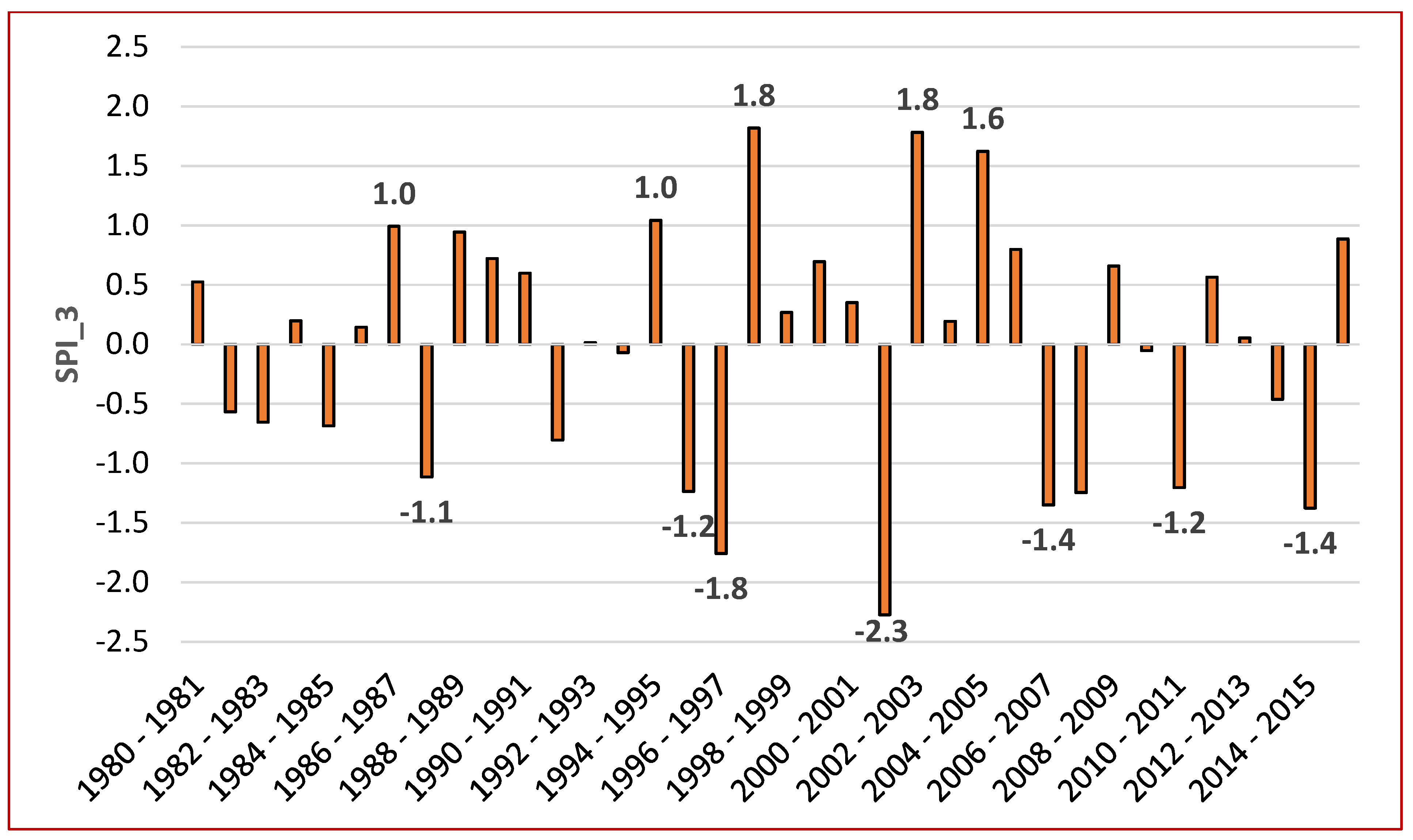
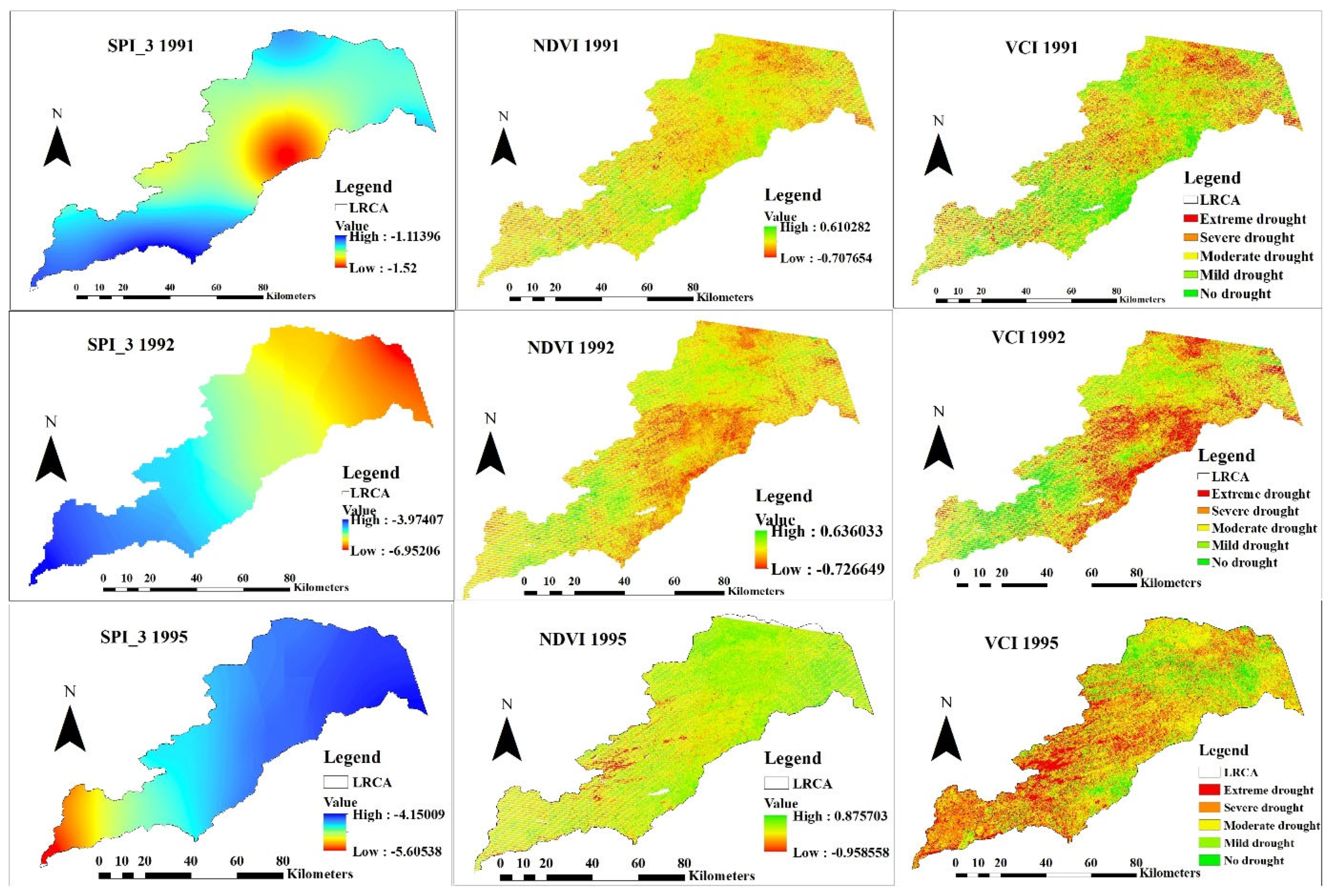
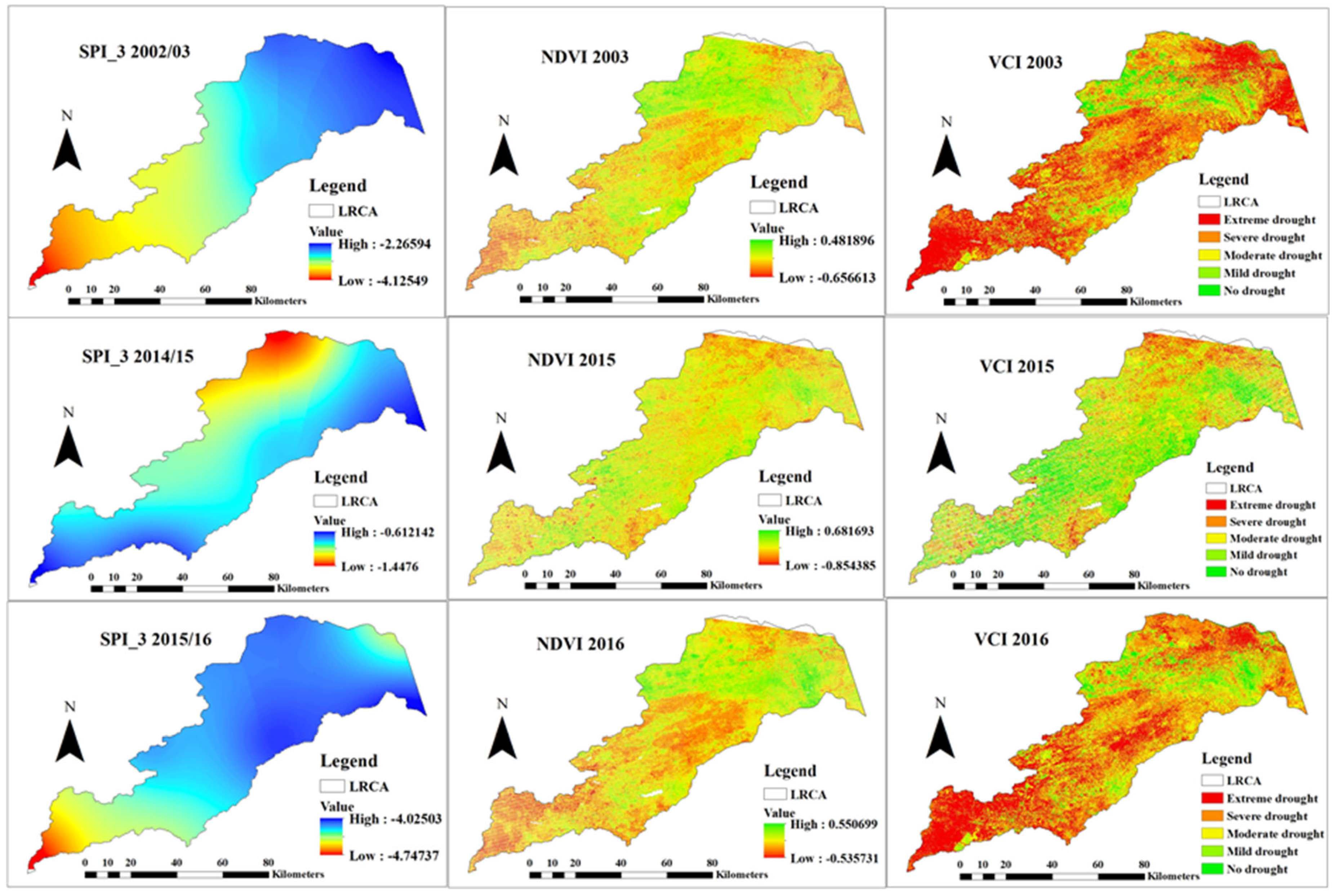
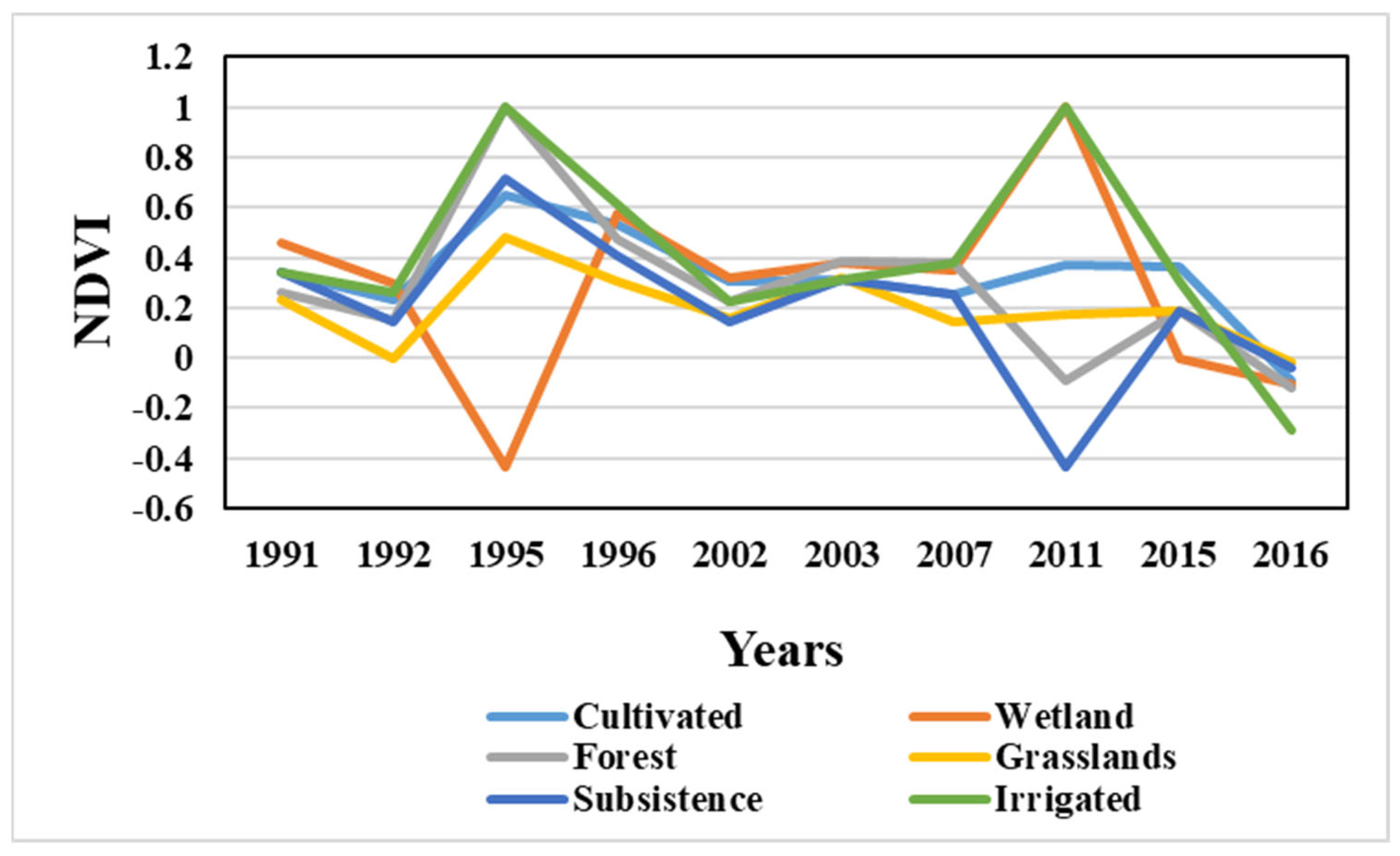
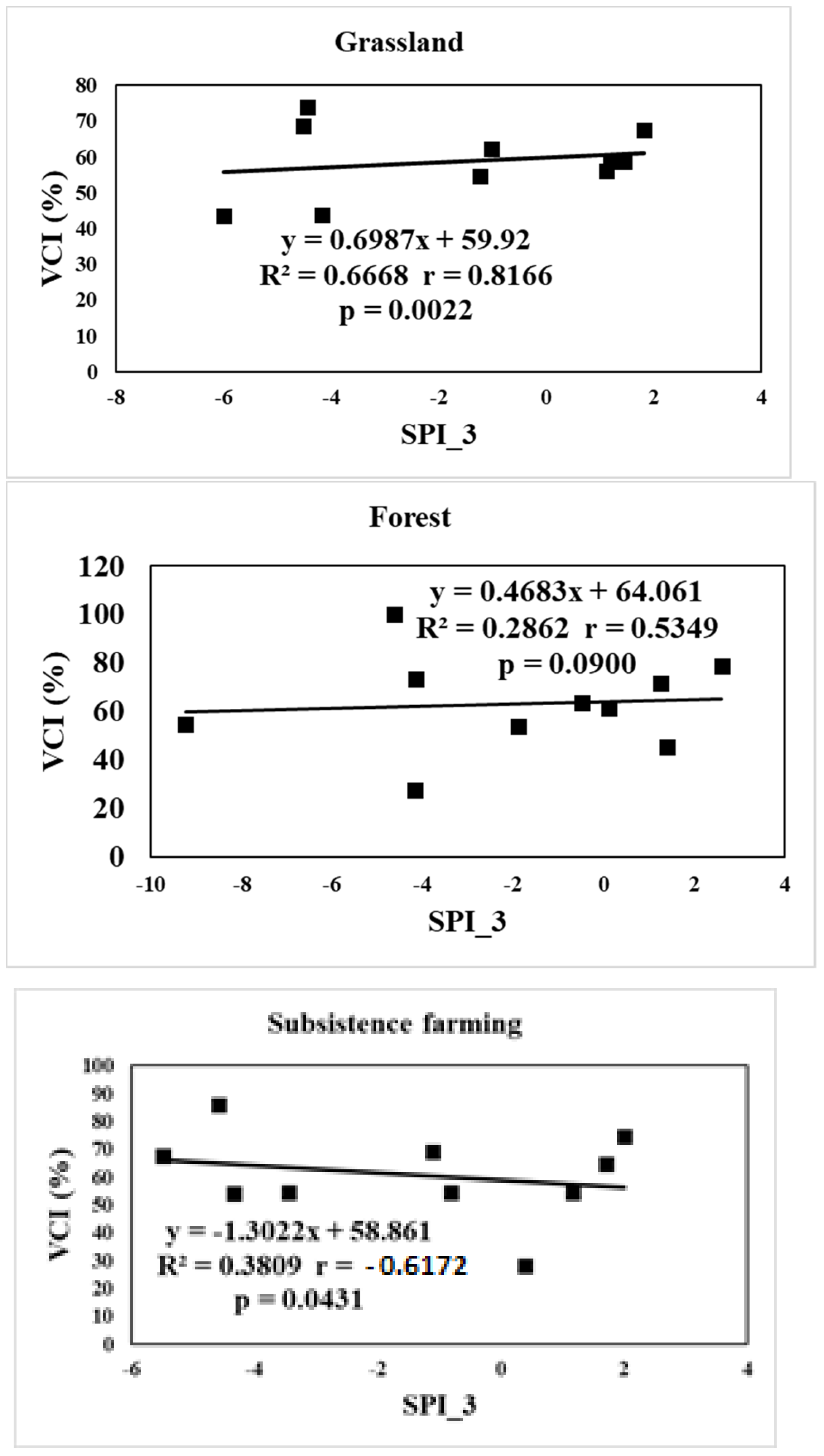
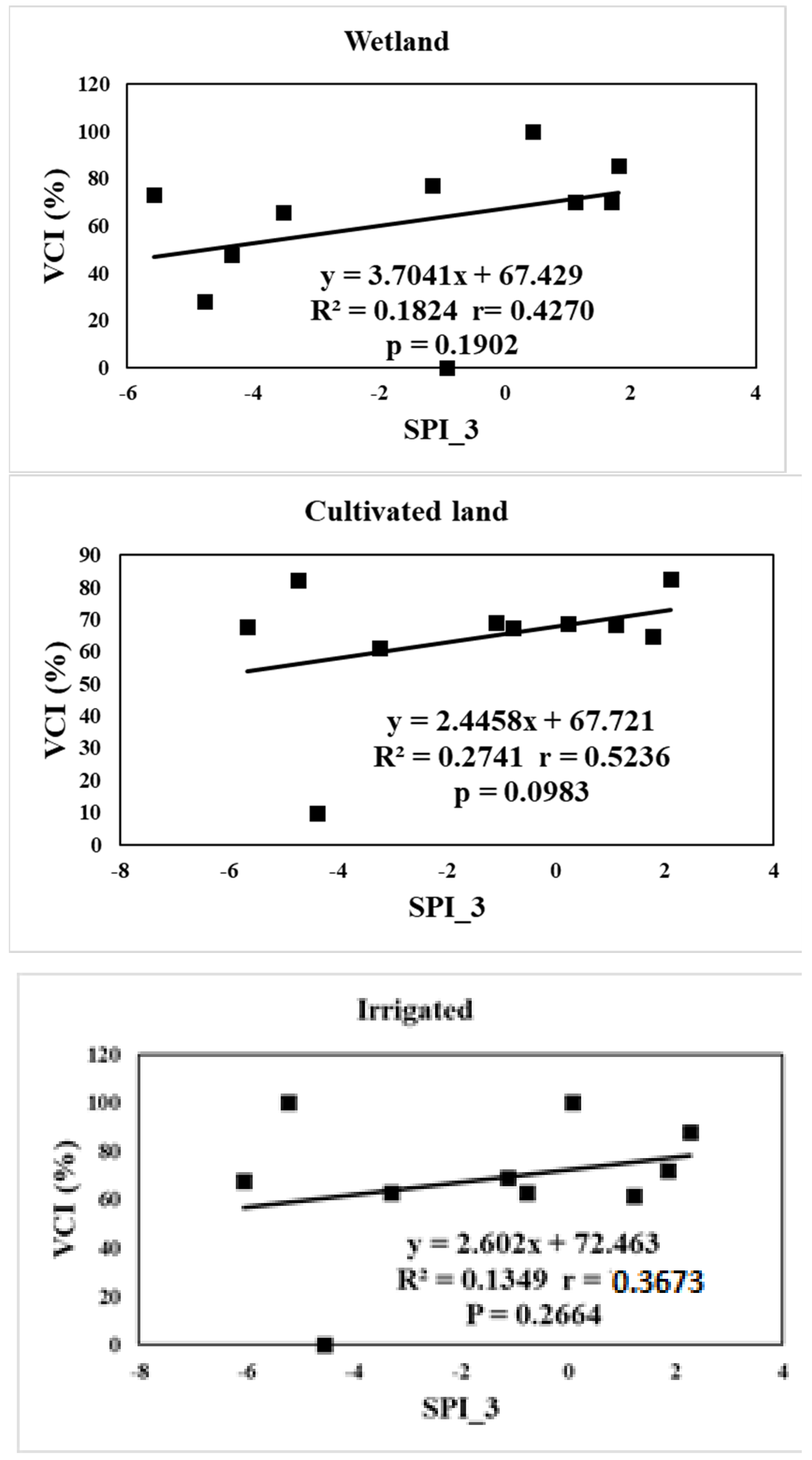
Publisher’s Note: MDPI stays neutral with regard to jurisdictional claims in published maps and institutional affiliations. |
© 2021 by the authors. Licensee MDPI, Basel, Switzerland. This article is an open access article distributed under the terms and conditions of the Creative Commons Attribution (CC BY) license (https://creativecommons.org/licenses/by/4.0/).
Share and Cite
Mukwada, G.; Mazibuko, S.M.; Moeletsi, M.; Robinson, G.M. Can Famine Be Averted? A Spatiotemporal Assessment of The Impact of Climate Change on Food Security in The Luvuvhu River Catchment of South Africa. Land 2021, 10, 527. https://doi.org/10.3390/land10050527
Mukwada G, Mazibuko SM, Moeletsi M, Robinson GM. Can Famine Be Averted? A Spatiotemporal Assessment of The Impact of Climate Change on Food Security in The Luvuvhu River Catchment of South Africa. Land. 2021; 10(5):527. https://doi.org/10.3390/land10050527
Chicago/Turabian StyleMukwada, Geoffrey, Sabelo M. Mazibuko, Mokhele Moeletsi, and Guy M. Robinson. 2021. "Can Famine Be Averted? A Spatiotemporal Assessment of The Impact of Climate Change on Food Security in The Luvuvhu River Catchment of South Africa" Land 10, no. 5: 527. https://doi.org/10.3390/land10050527
APA StyleMukwada, G., Mazibuko, S. M., Moeletsi, M., & Robinson, G. M. (2021). Can Famine Be Averted? A Spatiotemporal Assessment of The Impact of Climate Change on Food Security in The Luvuvhu River Catchment of South Africa. Land, 10(5), 527. https://doi.org/10.3390/land10050527







